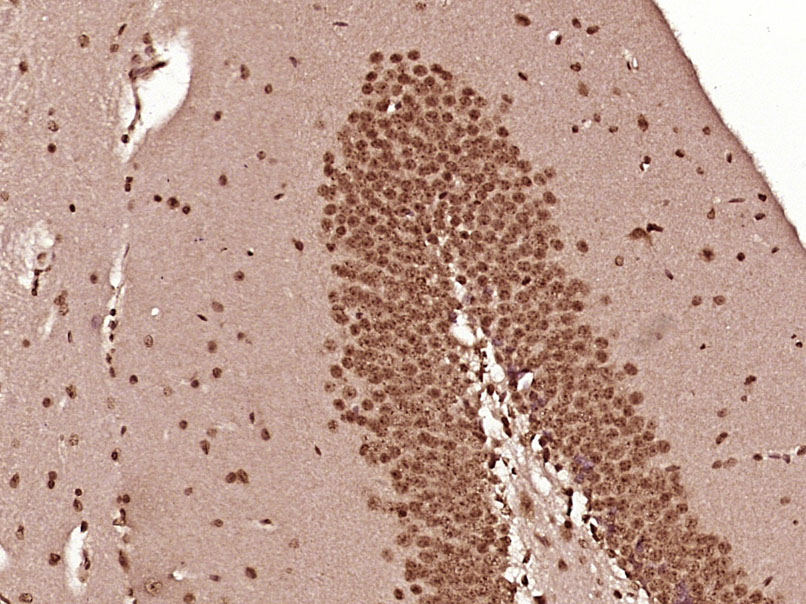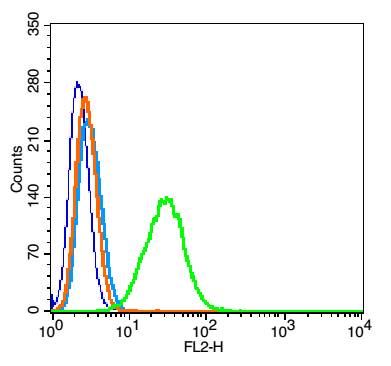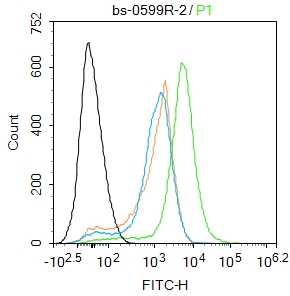
Rabbit Anti-E2F1 antibody
E2F 1; E2F transcription factor 1; E2F-1; E2f1 E2F transcription factor 1; KIAA4009; mKIAA4009; OTTHUMP00000030661; PBR 3; PBR3; PRB binding protein E2F 1; PRB-binding protein E2F-1; RBAP 1; RBAP-1; RBAP1; RBBP 3; RBBP-3; RBBP3; RBP 3; RBP3; Retinoblastom
View History [Clear]
Details
Product Name E2F1 Chinese Name 转录因子E2F-1抗体 Alias E2F 1; E2F transcription factor 1; E2F-1; E2f1 E2F transcription factor 1; KIAA4009; mKIAA4009; OTTHUMP00000030661; PBR 3; PBR3; PRB binding protein E2F 1; PRB-binding protein E2F-1; RBAP 1; RBAP-1; RBAP1; RBBP 3; RBBP-3; RBBP3; RBP 3; RBP3; Retinoblastoma associated protein 1; Retinoblastoma binding protein 3; Retinoblastoma-associated protein 1; Retinoblastoma-binding protein 3; Transcription factor E2F1; E2F1_HUMAN. literatures Research Area Tumour transcriptional regulatory factor Epigenetics Immunogen Species Rabbit Clonality Polyclonal React Species Human, Mouse, Rat, Applications ELISA=1:5000-10000 IHC-P=1:100-500 IHC-F=1:100-500 Flow-Cyt=0.2μg/Test IF=1:100-500 (Paraffin sections need antigen repair)
not yet tested in other applications.
optimal dilutions/concentrations should be determined by the end user.Theoretical molecular weight 46kDa Cellular localization The nucleus Form Liquid Concentration 1mg/ml immunogen KLH conjugated synthetic peptide derived from human E2F1: 101-180/437 Lsotype IgG Purification affinity purified by Protein A Buffer Solution 0.01M TBS(pH7.4) with 1% BSA, 0.03% Proclin300 and 50% Glycerol. Storage Shipped at 4℃. Store at -20 °C for one year. Avoid repeated freeze/thaw cycles. Attention This product as supplied is intended for research use only, not for use in human, therapeutic or diagnostic applications. PubMed PubMed Product Detail The protein encoded by this gene is a member of the E2F family of transcription factors. The E2F family plays a crucial role in the control of cell cycle and action of tumor suppressor proteins and is also a target of the transforming proteins of small DNA tumor viruses. The E2F proteins contain several evolutionally conserved domains found in most members of the family. These domains include a DNA binding domain, a dimerization domain which determines interaction with the differentiation regulated transcription factor proteins (DP), a transactivation domain enriched in acidic amino acids, and a tumor suppressor protein association domain which is embedded within the transactivation domain. This protein and another 2 members, E2F2 and E2F3, have an additional cyclin binding domain. This protein binds preferentially to retinoblastoma protein pRB in a cell-cycle dependent manner. It can mediate both cell proliferation and p53-dependent/independent apoptosis. [provided by RefSeq, Jul 2008]
Function:
Transcription activator that binds DNA cooperatively with dp proteins through the E2 recognition site, 5'-TTTC[CG]CGC-3' found in the promoter region of a number of genes whose products are involved in cell cycle regulation or in DNA replication. The DRTF1/E2F complex functions in the control of cell-cycle progression from G1 to S phase. E2F-1 binds preferentially RB1 protein, in a cell-cycle dependent manner. It can mediate both cell proliferation and p53-dependent apoptosis.
Subunit:
Component of the DRTF1/E2F transcription factor complex. Forms heterodimers with DP family members. The E2F-1 complex binds specifically hypophosphorylated retinoblastoma protein RB1. During the cell cycle, RB1 becomes phosphorylated in mid-to-late G1 phase, detaches from the DRTF1/E2F complex, rendering E2F transcriptionally active. Interacts with TRRAP, which probably mediates its interaction with histone acetyltransferase complexes, leading to transcription activation. Binds TOPBP1. Interacts with ARID3A. Binds EAPP.
Subcellular Location:
Nucleus.
Post-translational modifications:
Phosphorylated by CDK2 and cyclin A-CDK2 in the S-phase. Acetylation stimulates DNA-binding. Enhanced under stress conditions such as DNA damage and inhibited by retinoblastoma protein pRB. Regulated by KAP1/TRIM28 which recruits HDAC1 to E2F1 resulting in deacetylation. Acetylated by P/CAF/KAT2B.
Similarity:
Belongs to the E2F/DP family.
SWISS:
Q01094
Gene ID:
1869
Database links:Entrez Gene: 1869 Human
Entrez Gene: 13555 Mouse
Omim: 189971 Human
SwissProt: Q01094 Human
SwissProt: Q61501 Mouse
Unigene: 654393 Human
Unigene: 18036 Mouse
Unigene: 72471 Rat
transcriptional regulatory factor(Transcriptin Regulators)
E2F1—属于调节性转录因子E2F家族。有学者认为:E2F-1既可作为癌基因起作用,又可作为抑癌基因起作用。其不同可能由细胞中其他生长促进或抑制性蛋白质水平和(或)活性决定,同时与细胞所处环境及器官特异性有关。在控制细胞周期和Tumour抑制基因蛋白的活性方面起关键作用。Product Picture
Primary Antibody:Rabbit Anti-E2F1 antibody(SL0599R), Dilution: 0.2μg in 100 μL 1X PBS containing 0.5% BSA;
Isotype Control Antibody: Rabbit IgG(orange) ,used under the same conditions );
Secondary Antibody: Goat anti-rabbit IgG-PE(white blue), Dilution: 1:200 in 1 X PBS containing 0.5% BSA.
Protocol
The cells were fixed with 2% paraformaldehyde (10 min) , then permeabilized with 90% ice-cold methanol for 30 min on ice. Primary antibody (SL0599R,0.2μg /1x10^6 cells) were incubated for 30 min on the ice, followed by 1 X PBS containing 0.5% BSA + 1 0% goat serum (15 min) to block non-specific protein-protein interactions. Then the Goat Anti-rabbit IgG/PE antibody was added into the blocking buffer mentioned above to react with the primary antibody at 1/200 dilution for 30 min on ice. Acquisition of 20,000 events was performed.Blank control:Mosue spleen.
Primary Antibody (green line): Rabbit Anti-E2F1 antibody (SL0599R)
Dilution: 2μg /10^6 cells;
Isotype Control Antibody (orange line): Rabbit IgG .
Secondary Antibody : Goat anti-rabbit IgG-FITC
Dilution: 1μg /test.
Protocol
The cells were fixed with 4% PFA (10min at room temperature)and then permeabilized with 90% ice-cold methanol for 20 min at -20℃. The cells were then incubated in 5%BSA to block non-specific protein-protein interactions for 30 min at room temperature .Cells stained with Primary Antibody for 30 min at room temperature. The secondary antibody used for 40 min at room temperature. Acquisition of 20,000 events was performed.
References (0)
No References
Bought notes(bought amounts latest0)
No one bought this product
User Comment(Total0User Comment Num)
- No comment





 +86 571 56623320
+86 571 56623320
 +86 18668110335
+86 18668110335

